Persistent ictal-like activity in rat entorhinal/perirhinal cortex following washout of 4-aminopyridine
- PMID: 21353480
- PMCID: PMC3151330
- DOI: 10.1016/j.eplepsyres.2011.01.017
Persistent ictal-like activity in rat entorhinal/perirhinal cortex following washout of 4-aminopyridine
Abstract
Application of 4-aminopyridine (4-AP, 100μM) in a solution containing 0.6mM Mg(2+) and 1.2mM Ca(2+) to hippocampal-entorhinal-perirhinal slices of adult rat brain induced ictal-like epileptiform activity in entorhinal and perirhinal cortices as revealed by electrophysiological field potential recordings. The ictal-like activity persisted after washing out the 4-AP. This persistence indicated that a change had occurred in the slice so that it was now "epileptic" in the absence of the convulsant 4-AP. Induction of persistent ictal-like activity was dependent upon the concentration of divalent cations during 4-AP exposure; that is, although 4-AP caused ictal-like activity in approximately half the slices in solution containing 1.6mM Mg(2+) and 2.0mM Ca(2+), this ictal-like activity did not persist upon washout of the 4-AP. Expression of the persistent ictal-like epileptiform activity required ionotropic glutamate-mediated synaptic transmission: application of the AMPA/kainate receptor antagonist NBQX after 4-AP washout reduced persistent ictal-like activity, and the combined application of NBQX and the NMDA receptor antagonist d-AP5 completely blocked it. In order to investigate the mechanism of induction of persistent ictal-like activity, several agents were applied before the introduction of 4-AP. Application of d-AP5 did not block the onset of ictal-like activity upon introduction of 4-AP but did prevent the persistence of the ictal-like activity upon washout of the 4-AP. In contrast, induction of persistent ictal-like activity was not prevented by simultaneous application of the group I metabotropic glutamate receptor (mGluR) antagonists LY 367385 and MPEP or by application of the protein synthesis inhibitor cycloheximide. In conclusion, we have characterized a new in vitro model of epileptogenesis in which induction of ictal-like activity is dependent upon NMDA receptor activation but not upon group I mGluR activation or protein synthesis.
Copyright © 2011 Elsevier B.V. All rights reserved.
Figures
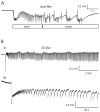
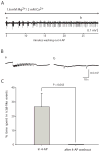
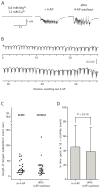
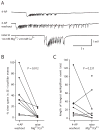
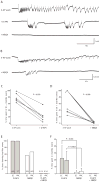
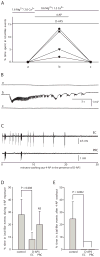
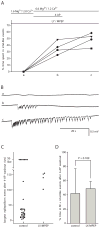
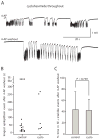
Similar articles
-
Effects of subtype-selective group I mGluR antagonists on synchronous activity induced by 4-aminopyridine/CGP 55845 in adult guinea pig hippocampal slices.Neuropharmacology. 2008 Jul;55(1):47-54. doi: 10.1016/j.neuropharm.2008.04.010. Epub 2008 Apr 23. Neuropharmacology. 2008. PMID: 18538357 Free PMC article.
-
Initiation of electrographic seizures by neuronal networks in entorhinal and perirhinal cortices in vitro.Neuroscience. 2004;123(4):875-86. doi: 10.1016/j.neuroscience.2003.11.013. Neuroscience. 2004. PMID: 14751281
-
Reduced ictogenic potential of 4-aminopyridine in the perirhinal and entorhinal cortex of kainate-treated chronic epileptic rats.Neurobiol Dis. 2008 Feb;29(2):186-200. doi: 10.1016/j.nbd.2007.08.013. Epub 2007 Sep 4. Neurobiol Dis. 2008. PMID: 17942314
-
Synchronous GABA-mediated potentials and epileptiform discharges in the rat limbic system in vitro.J Neurosci. 1996 Jun 15;16(12):3912-24. doi: 10.1523/JNEUROSCI.16-12-03912.1996. J Neurosci. 1996. PMID: 8656285 Free PMC article.
-
Do interictal discharges promote or control seizures? Experimental evidence from an in vitro model of epileptiform discharge.Epilepsia. 2001;42 Suppl 3:2-4. doi: 10.1046/j.1528-1157.2001.042suppl.3002.x. Epilepsia. 2001. PMID: 11520313 Review.
Cited by
-
Tools, methods, and applications for optophysiology in neuroscience.Front Mol Neurosci. 2013 Jul 17;6:18. doi: 10.3389/fnmol.2013.00018. eCollection 2013. Front Mol Neurosci. 2013. PMID: 23882179 Free PMC article.
-
Beneficial Effects of Selective Orexin-A Receptor Antagonist in 4-aminopyridine-induced Seizures in Male Rats.Adv Biomed Res. 2017 Dec 26;6:162. doi: 10.4103/abr.abr_262_16. eCollection 2017. Adv Biomed Res. 2017. PMID: 29387673 Free PMC article.
-
Targeted deletion of Kcne2 impairs HCN channel function in mouse thalamocortical circuits.PLoS One. 2012;7(8):e42756. doi: 10.1371/journal.pone.0042756. Epub 2012 Aug 3. PLoS One. 2012. PMID: 22880098 Free PMC article.
-
Brain extracellular space, hyaluronan, and the prevention of epileptic seizures.Rev Neurosci. 2017 Nov 27;28(8):869-892. doi: 10.1515/revneuro-2017-0017. Rev Neurosci. 2017. PMID: 28779572 Free PMC article. Review.
-
The piriform, perirhinal, and entorhinal cortex in seizure generation.Front Neural Circuits. 2015 May 29;9:27. doi: 10.3389/fncir.2015.00027. eCollection 2015. Front Neural Circuits. 2015. PMID: 26074779 Free PMC article. Review.
References
-
- Aram JA, Michelson HB, Wong RK. Synchronized GABAergic IPSPs recorded in the neocortex after blockade of synaptic transmission mediated by excitatory amino acids. J Neurophysiol. 1991;65:1034–1041. - PubMed
-
- Arvanov VL, Holmes KH, Keele NB, Shinnick-Gallagher P. The functional role of metabotropic glutamate receptors in epileptiform activity induced by 4-aminopyridine in the rat amygdala slice. Brain Res. 1995;669:140–144. - PubMed
Publication types
MeSH terms
Substances
Grants and funding
LinkOut - more resources
Full Text Sources
Miscellaneous

